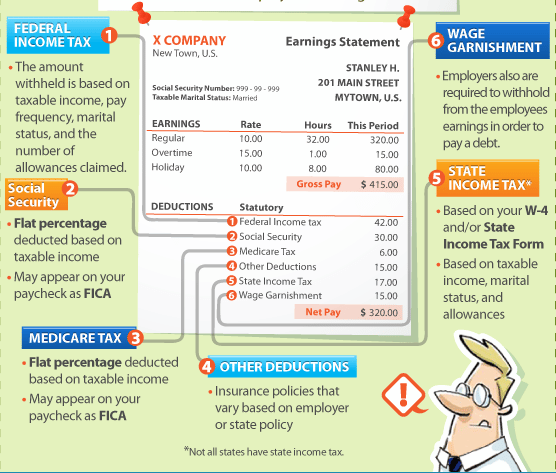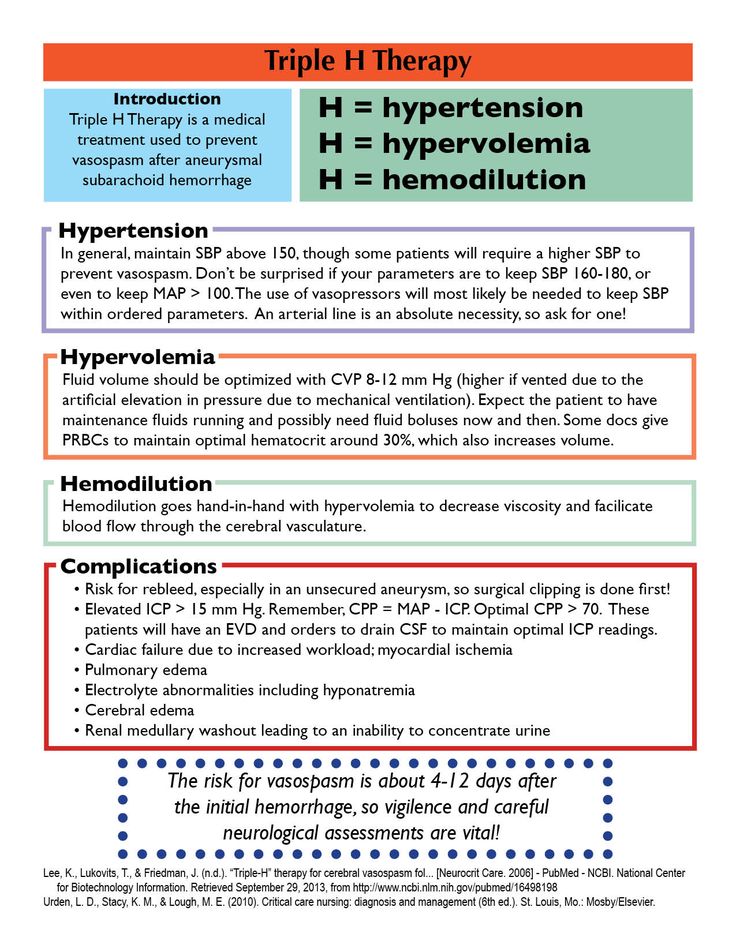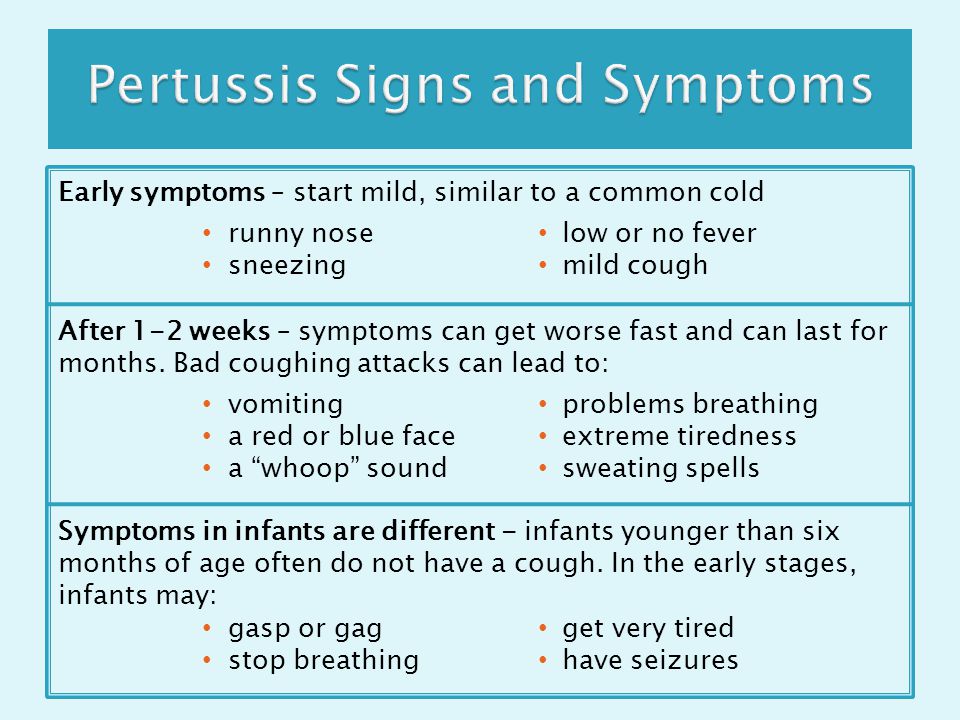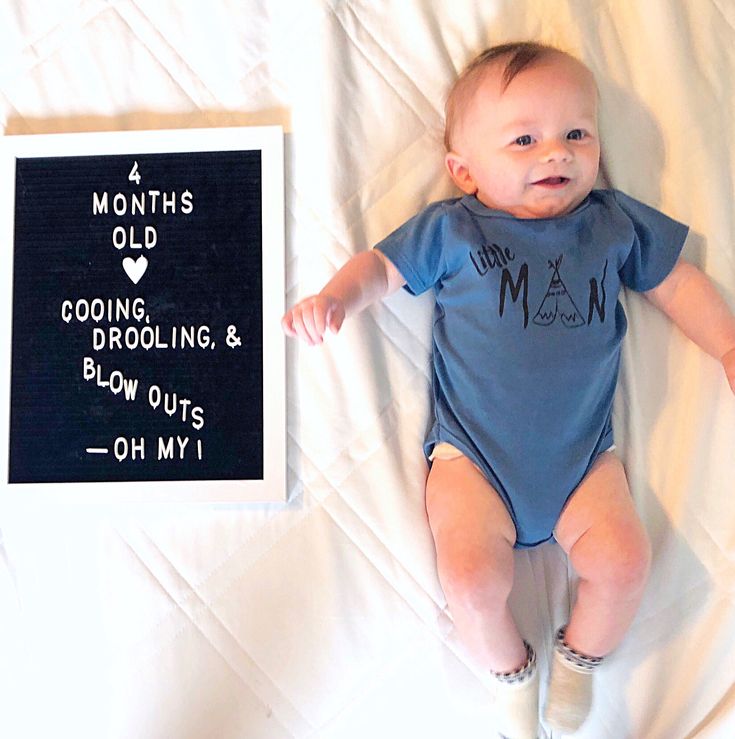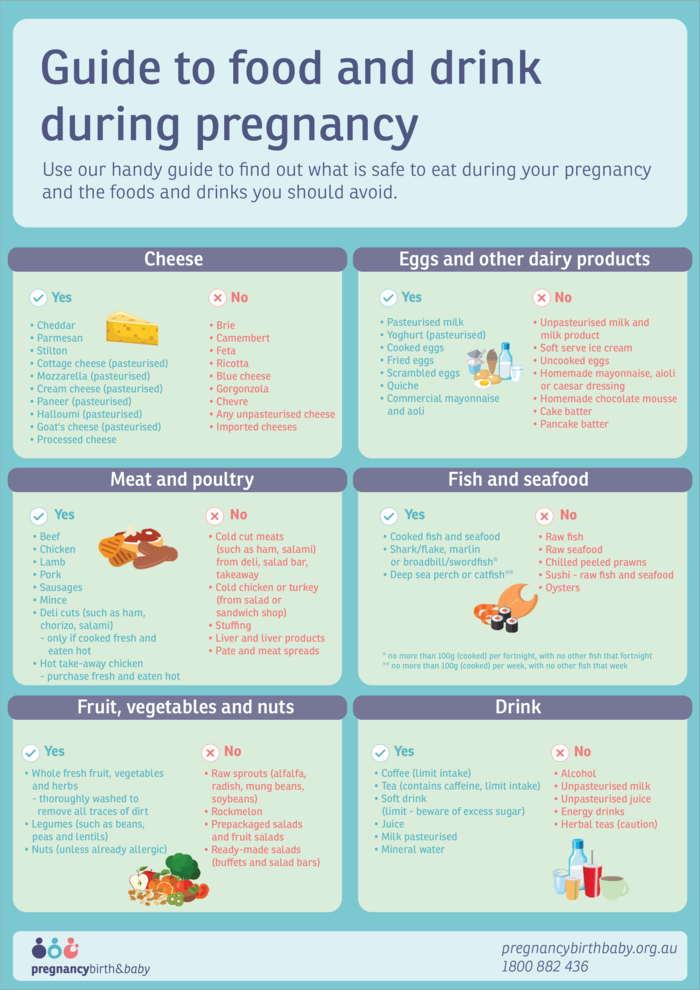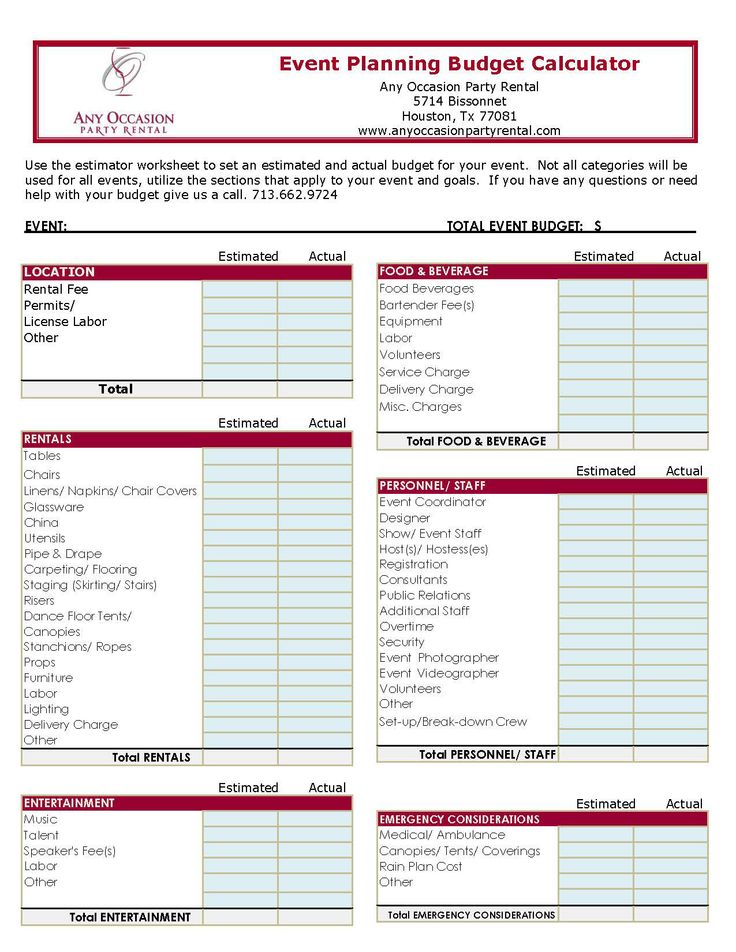When do feet start to swell in pregnancy
Causes, Plus Treatments That Work
While you may be enjoying the magical time that is pregnancy — it truly is miraculous how many restroom trips you can squeeze into one day — and eagerly anticipating the arrival of your sweet little bundle, there are some less than magical side effects that many parents-to-be experience.
Your body is changing rapidly, which can get a little uncomfortable. One discomfort that many people experience during pregnancy is swollen feet.
Let’s talk about why your feet may swell during pregnancy, when you might notice this happening, when you should seek medical attention, and some simple treatments that can help.
While swollen feet may or may not be painful, they can certainly be uncomfortable or bothersome.
Fortunately, you can try several simple strategies to help ease your symptoms during pregnancy.
Even better? They may involve snacks, a cold drink, swimming, massage, and possibly shoe shopping. Doesn’t sound so bad, right?
1.
One way to reduce swelling during pregnancy is to limit your sodium (salt) intake. Salt makes your body hold on to extra water.
Try to avoid canned or processed foods, as these are especially high in sodium. Also, try not to put extra table salt on your food.
Using savory herbs such as rosemary, thyme, and oregano is an easy way to add flavor to your recipes without using salt.
2. Increase potassium intake
Not getting enough potassium can also make swelling worse. This is because potassium helps your body balance the amount of fluids it holds onto.
Your prenatal vitamin should have some extra potassium for you, but it’s also important to eat good sources of dietary potassium.
Some foods that are naturally high in potassium include:
- potatoes with the skin on
- sweet potatoes, also with the skin on
- bananas
- spinach
- beans
- some fruit juices, especially:
- prune
- pomegranate
- orange
- carrot
- passionfruit
- yogurt
- beets
- salmon
- lentils
3.
 Reduce caffeine intake
Reduce caffeine intakeWhile occasional caffeine during pregnancy isn’t harmful (and hey, a person’s gotta stay awake!), drinking too much caffeine isn’t considered great for a baby. It can also make swelling worse.
Caffeine is a diuretic, which causes you to pee more, which then makes your body think it needs to hold on to fluid.
Try a decaf coffee with milk or an herbal tea such as peppermint to help give you a little energy boost instead.
4. Drink more water
As strange as it sounds to drink more water to counteract swelling, it actually works. If your body thinks you’re dehydrated, it will hold on to even more fluid to try to compensate.
So try to drink at least 10 glasses of water every day to keep your kidneys flushing out the bad stuff and your body happily hydrated.
If it feels daunting to drink that much water, try getting a cute cup that you’ll want to keep refilling, or a giant water bottle that you’ll only have to refill a couple of times per day.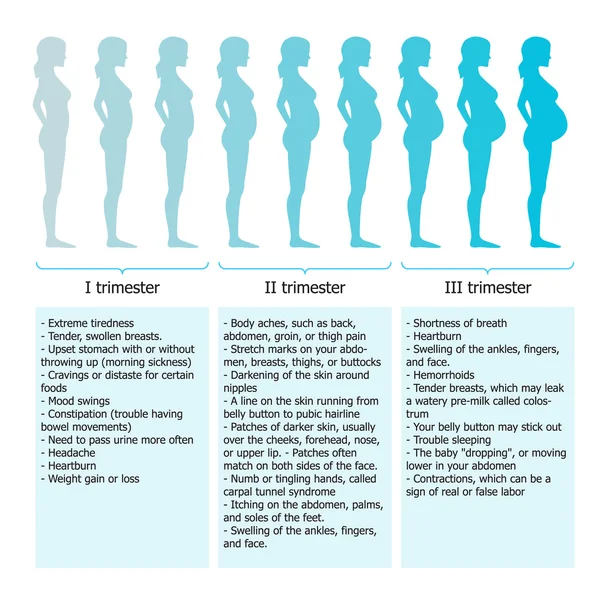 You can also flavor your water with lemon, mint, or berries to make it more enjoyable.
You can also flavor your water with lemon, mint, or berries to make it more enjoyable.
5. Elevate your feet and rest
Even though you have a million things you want to get done before baby arrives, try to sit and put your feet up when possible.
While sitting all the time isn’t great for your circulation, standing all the time is also hard on your beautiful pregnant body.
Sitting with your feet elevated for a little while — especially at the end of the day — can help drain the fluid that’s been pooling in your legs over the course of the day.
6. Wear loose, comfortable clothing
Wearing tight clothing, especially around your wrists, waist, and ankles, can make swelling worse. Basically, it keeps blood from circulating as easily as it could.
Try to wear loose, comfortable clothes — or at least avoid tight elastic bands. Maternity maxi dresses in the summer and flowy cardigans or sweaters with joggers in the winter can be both cute and comfortable.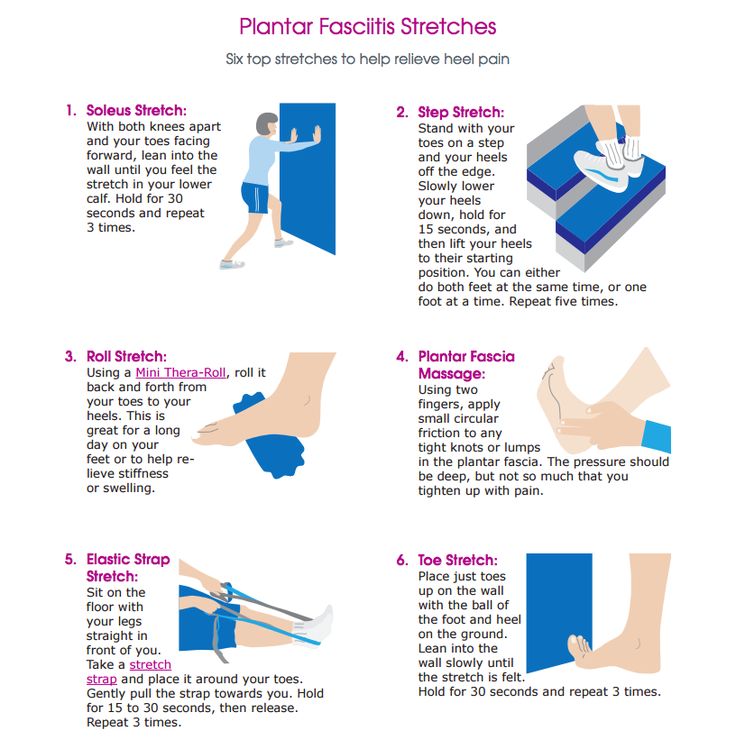
7. Stay cool
Especially if you’re pregnant during the hot summer months, staying indoors during the heat of the day and avoiding vigorous exercise can help keep you cool and reduce swelling.
You can also wear cool clothing, put cold compresses on your feet, or keep a fan nearby.
8. Wear waist-high compression stockings
Yes, these are just about as appealing as they sound. But if you’re experiencing persistently swollen feet or have to be on your feet most of the time, you can wear waist-high compression stockings.
These stockings gently squeeze your feet and legs to help keep fluid circulating. Try to avoid the knee-high compression stockings, as they may be too tight in the middle of your leg and actually make swelling worse.
9. Walk
Going for even a 5- or 10-minute walk a couple of times per day can help improve your circulation, which helps reduce swelling.
This can also be a good break in your day, and it’s a great way to get pregnancy-safe exercise.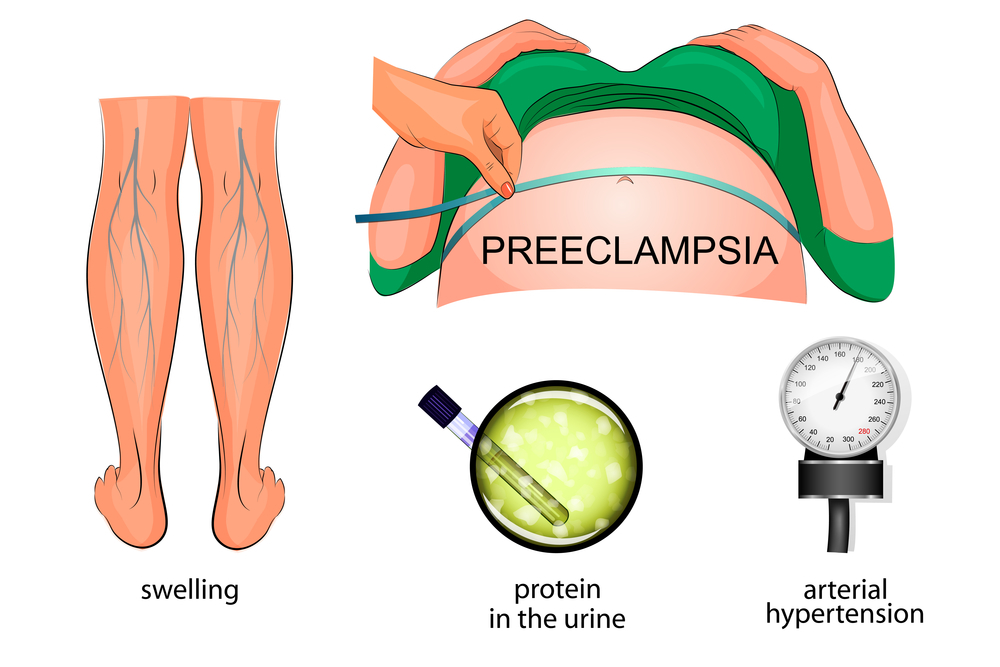
10. Wear comfortable shoes
While you may look adorable in your high heels, late pregnancy is a good time to give them a break.
Wearing comfortable (even orthotic), well-fitting shoes is key to reducing foot swelling, as well as to preventing hip and back problems that can arise as your center of gravity shifts and your weight increases.
In addition to the swelling, the ligaments in your body (including your feet) actually do stretch during pregnancy, so your feet may change size. Some people’s feet return to their pre-pregnancy size, but many people find that their feet are permanently a half-size or so larger.
It may be annoying that one more thing is changing or that some of your beloved shoes no longer fit, but this is an excellent excuse to find some new favorites.
11. Swim
There are no studies proving that water pressure reduces swelling during pregnancy, but many people do find relief from swelling when they spend time in the pool.
Try standing or swimming in a pool where the water depth is almost up to your neck.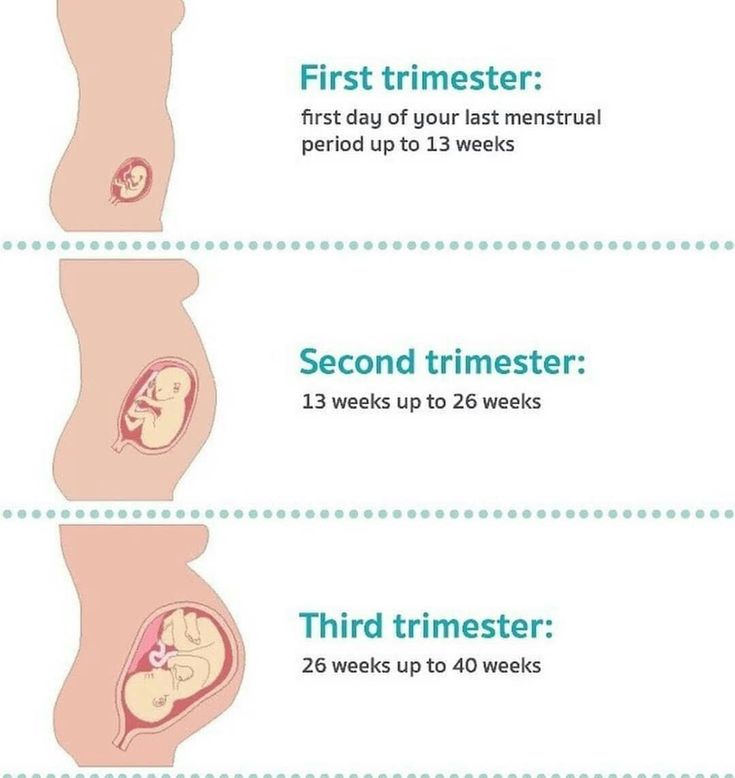 At the very least, you will feel lighter and cooler, plus get a little exercise. You may also find that your feet and legs are less swollen.
At the very least, you will feel lighter and cooler, plus get a little exercise. You may also find that your feet and legs are less swollen.
12. Get a massage
Your partner may be looking for ways to be involved during the pregnancy process, and this is the perfect opportunity.
Massage helps circulate the fluids that tend to accumulate in your feet, which will in turn reduce swelling.
So grab your water bottle, put your feet up, and let your partner gently massage your feet and legs. Adding some peppermint or lavender essential oil can make this even more relaxing.
And if you’re rocking this pregnancy solo or your partner isn’t the touchy-feely type, many massage studios offer specialized prenatal massages. These can not only help with swelling, but are great for helping relieve some of the stress that can accompany pregnancy.
13. Sleep on your left side
Sleeping on your left side when possible can improve blood flow, which reduces swelling of the feet. Lying on your left side takes the pressure of your uterus off of the inferior vena cava, which is the large blood vessel that returns blood to your heart.
Lying on your left side takes the pressure of your uterus off of the inferior vena cava, which is the large blood vessel that returns blood to your heart.
When can you expect your feet to start puffing up? Well, the good news is that it’s usually later on in pregnancy. So you’ll likely recognize your feet for the first half or more of your pregnancy.
First trimester
Rapidly increasing levels of the hormone progesterone (literally “pro gestation” or “pro pregnancy”) slow your digestion down. This can cause abdominal bloating long before you have a noticeable baby bump.
You may also notice a bit of puffiness in your hands, feet, or face — but not much.
If you notice a lot of swelling this early on, especially if accompanied by other symptoms such as dizziness, headaches, or bleeding, it’s best to call your doctor or birthing professional, such as a midwife.
Second trimester
The second trimester begins with week 14 of pregnancy, roughly the start of month 4. It’s not unusual to start noticing swollen feet around month 5 of pregnancy, especially if you’re on your feet a lot or the weather is hot.
It’s not unusual to start noticing swollen feet around month 5 of pregnancy, especially if you’re on your feet a lot or the weather is hot.
This swelling is due to the increasing volume of blood and fluids in your body. Your blood volume increases by about 50 percent during the course of your pregnancy, and that’s paired with a lot of hormonal fluid retention.
While it may make your rings and shoes a little snug, all this extra fluid helps to soften your body and prepare it for giving birth — and that’s exactly what you want. Rest assured, the extra fluid will rapidly decrease in the days and weeks after your baby is born.
Third trimester
Starting with week 28 of pregnancy, the third trimester is by far the most common time to experience swollen feet.
Especially as the weeks go on and you get closer to week 40, your toes are more likely to resemble little sausages than anything else (yes, becoming a parent is glamorous).
Your body is continuing to build its supply of blood and fluids, which can contribute to swelling.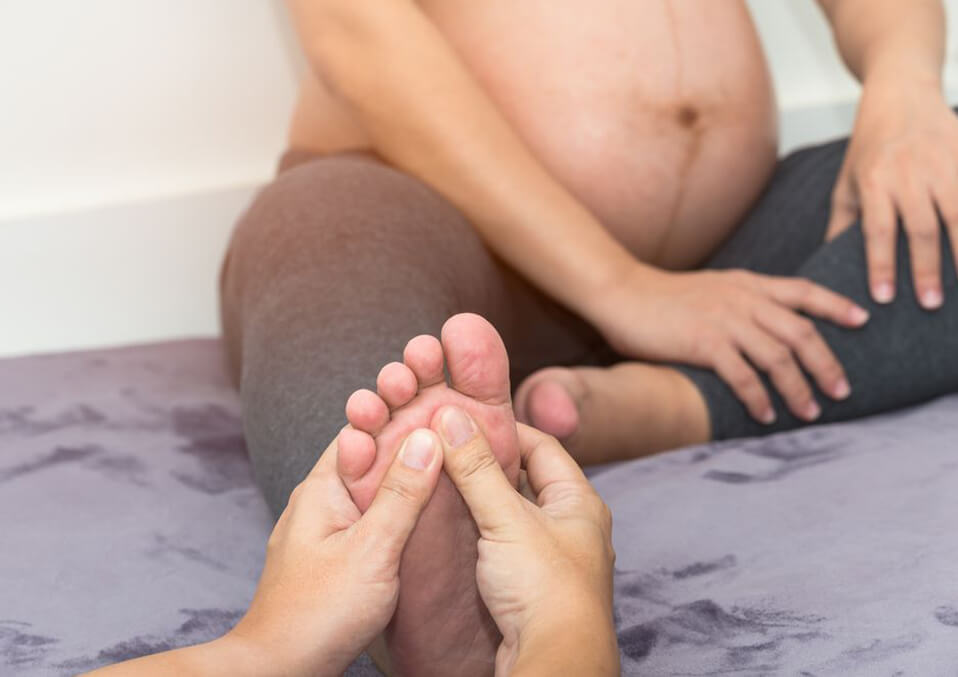 Your uterus is also getting much heavier as your baby grows, which can slow blood flow from the legs back to the heart. (Don’t worry, this isn’t dangerous — just uncomfortable.)
Your uterus is also getting much heavier as your baby grows, which can slow blood flow from the legs back to the heart. (Don’t worry, this isn’t dangerous — just uncomfortable.)
Other factors that can contribute to swollen feet include:
- hot weather
- dietary imbalances
- caffeine intake
- not drinking enough water
- being on your feet for long periods of time
Swollen feet are a very typical part of pregnancy, as many of your fellow pregnancy buddies can probably tell you! So most of the time, swollen feet are just another sign of all the hard work your body is doing to grow that new little life.
However, swollen feet can sometimes signal a more serious concern.
One of these concerns is called preeclampsia. This condition can develop during pregnancy and cause dangerously high blood pressure.
Call your birthing professional or doctor if you notice:
- sudden swelling of your hands, feet, face, or around your eyes
- swelling that gets dramatically worse
- dizziness or blurred vision
- a severe headache
- abdominal pain, especially in the upper right section of your abdomen
- confusion
- difficulty breathing
If you notice swelling in just one leg that is also accompanied by pain, redness, or heat, this could mean you have a deep vein thrombosis (DVT).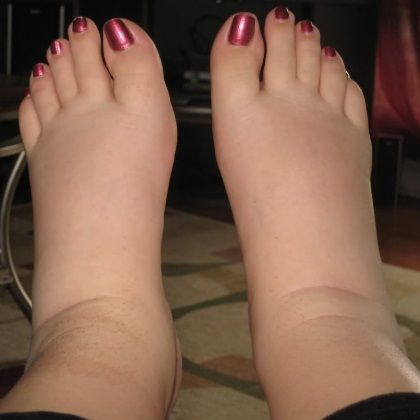 A DVT is a blood clot, usually in your leg.
A DVT is a blood clot, usually in your leg.
It’s important to call your healthcare professional immediately if you notice these symptoms. This is because people are more likely to get blood clots during pregnancy than when not pregnant (thanks once again, hormones).
If you’re unsure whether your swelling is typical or have any concerns, it is always best to call your doctor or midwife. They’re happy to help keep you and your baby safe and healthy!
Swollen feet are a very common side effect of pregnancy. Swelling is caused by increased fluid volume in your body, as well as decreased circulation.
If you experience sudden or severe swelling, it’s important to call your doctor or birthing professional, as this may be a sign of something more serious. But a little swelling is definitely expected.
You can help prevent foot swelling by getting regular gentle exercise, drinking plenty of water, resting, and eating a balanced diet.
Before you know it, your shoes will fit again and the only feet you’ll be focusing on will be those tiny baby toes!
For more pregnancy guidance and weekly tips tailored to your due date, sign up for our I’m Expecting newsletter.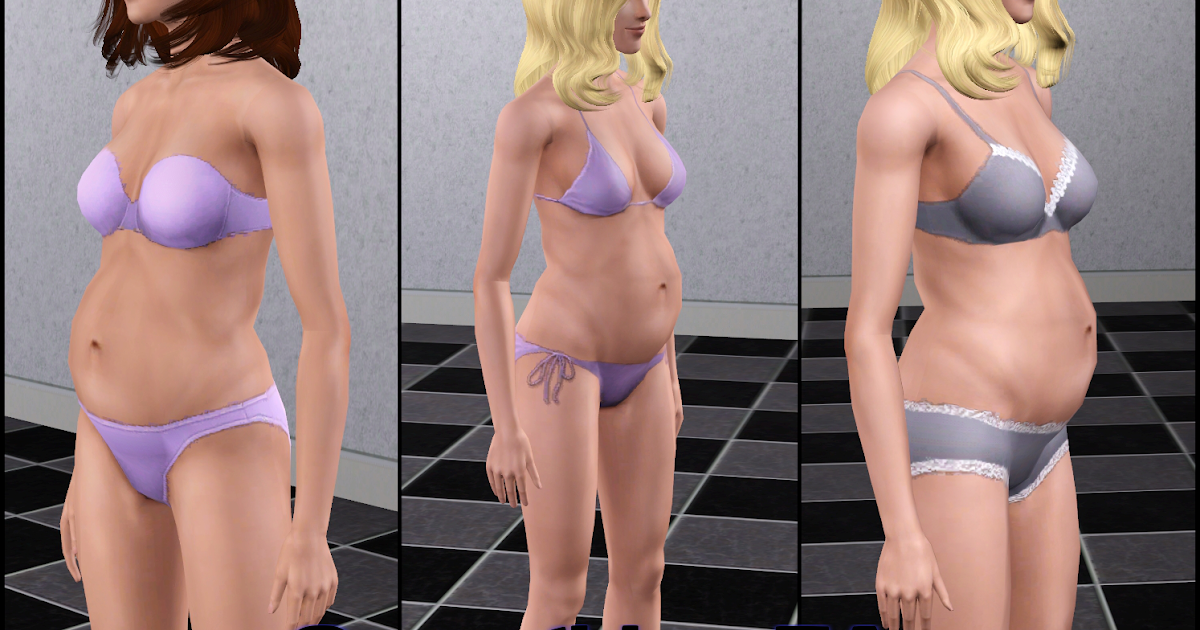
Swollen ankles, feet and fingers in pregnancy
It's normal to get some swelling in pregnancy, particularly in your legs, ankles, feet and fingers.
It's often worse at the end of the day and further into your pregnancy.
Swelling that comes on gradually is not usually harmful to you or your baby, but it can be uncomfortable.
A sudden increase in swelling can be a sign of pre-eclampsia, a condition that needs to be monitored as soon as possible.
Non-urgent advice: Call your midwife, GP or labour ward immediately if you have:
- a sudden increase in swelling in your face, hands or feet
- a very bad headache
- problems with your vision, such as blurring or flashing lights in your eyes
- severe pain just below your ribs
- vomiting with any of these symptoms
These could be symptoms of pre-eclampsia, which can lead to serious complications if it's not monitored and treated.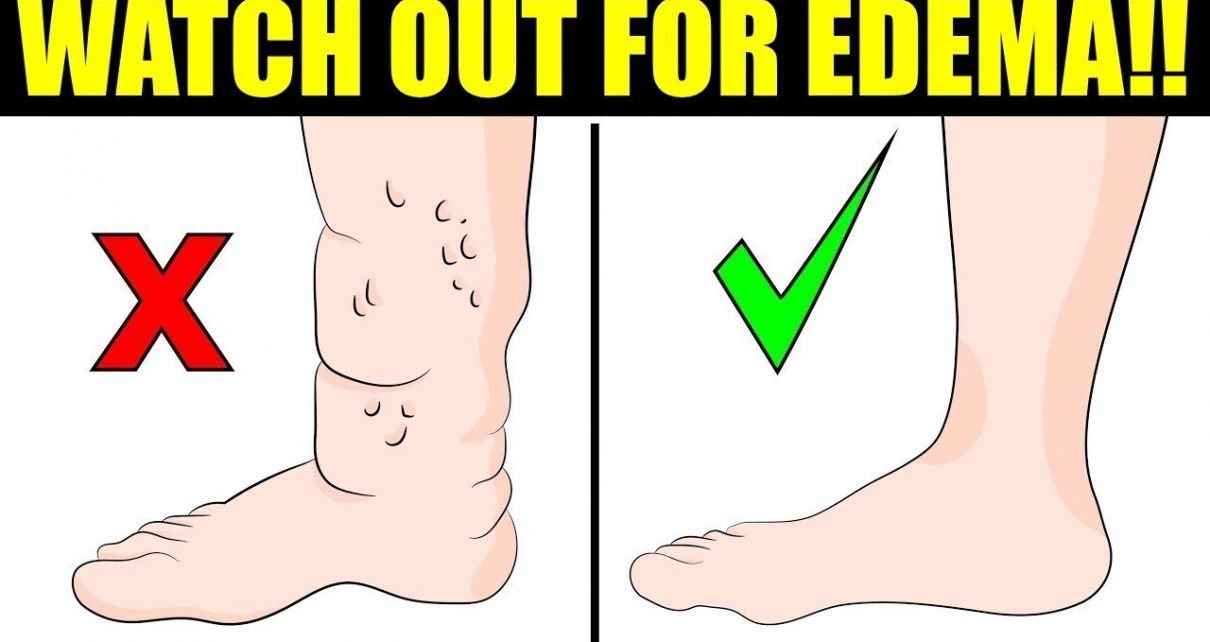
Normal pregnancy swelling
Swelling is caused by your body holding more water than usual when you're pregnant.
Throughout the day the extra water tends to gather in the lowest parts of the body, especially if the weather is hot or you have been standing a lot.
The pressure of your growing womb can also affect the blood flow in your legs. This can cause fluid to build up in your legs, ankles and feet.
What can help to reduce swelling
Try to:
- avoid standing for long periods
- wear comfortable shoes and socks – avoid tight straps or anything that might pinch if your feet swell
- try to rest with your feet up as much as you can
- drink plenty of water – this helps your body get rid of excess water
- exercise – try to take regular walks during the day or doing foot exercises
Foot exercises
You can do foot exercises sitting or standing. They improve blood circulation, reduce swelling in the ankles, and prevent cramp in the calf muscles:
They improve blood circulation, reduce swelling in the ankles, and prevent cramp in the calf muscles:
- bend and stretch your foot up and down 30 times
- rotate each foot in a circle 8 times one way and 8 times the other way
Get more tips on exercising in pregnancy.
Page last reviewed: 10 March 2021
Next review due: 10 March 2024
How to remove edema during pregnancy and why they are dangerous
Edema during pregnancy appears in most women "in position". Most often, they notice swelling in the third trimester, after 30 weeks, however, with late toxicosis, symptoms of fluid retention appear as early as the 18th week.
General information
During the period of bearing a child in a woman's body, the volume of fluid increases significantly, at least twice. As a result, the internal organs experience increased stress, which leads to swelling.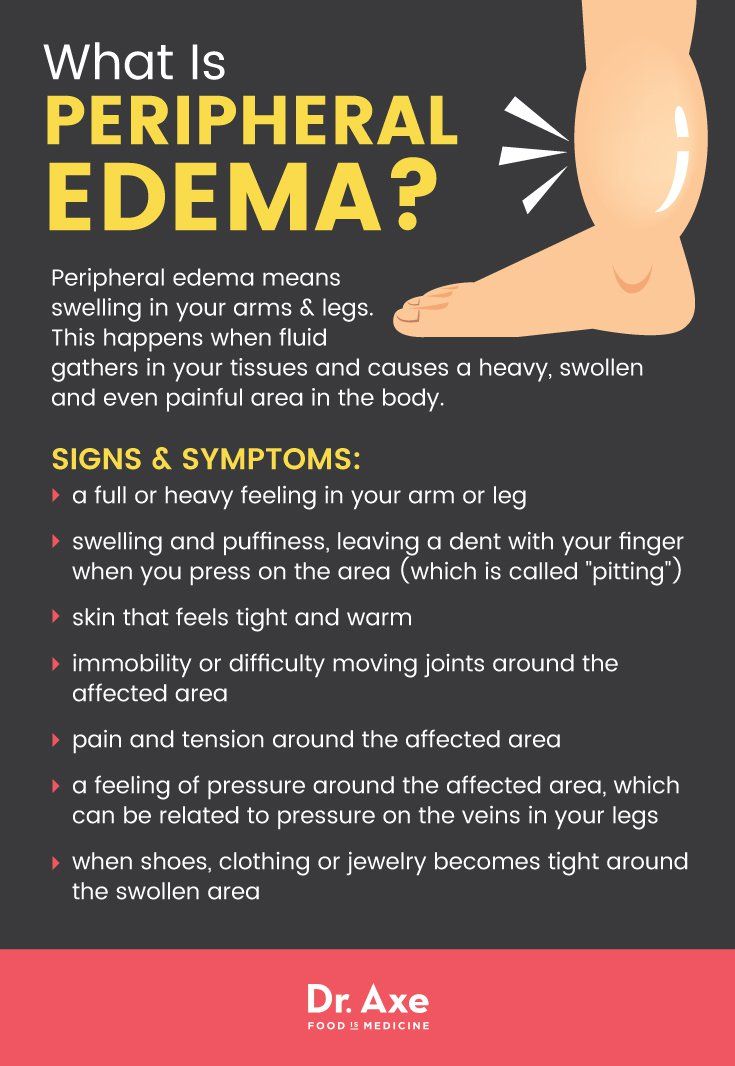 nine0003
nine0003
Most often in pregnant women, the legs swell in the area of \u200b\u200bthe feet and ankles, because under the influence of gravity, the water descends. But over time, swelling can spread to the hands, face, and sometimes the whole body.
Species
Given the prevalence, swelling during pregnancy is of 2 types:
1. Localized (local)
When only one part of the body swells - legs, arms or face. nine0003
2. Generalized (generalized)
In which edema spreads to the whole body.
Generalized edema is called dropsy of pregnancy and is a consequence of the release of plasma into the intercellular space. Puffiness is generally characteristic of late toxicosis, or gestosis, but it manifests itself with varying degrees of severity.
In some cases, gestosis is quite difficult and is accompanied by such conditions as: nine0003
- nephropathy
It develops against the background of dropsy in about a quarter of women.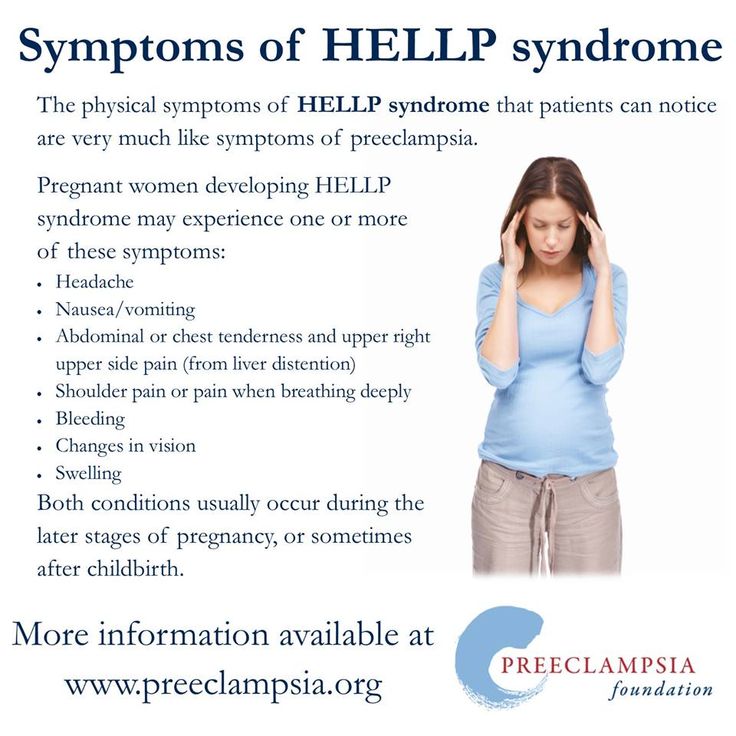 With nephropathy, blood pressure rises, dizziness, lower back pain, and digestive problems;
With nephropathy, blood pressure rises, dizziness, lower back pain, and digestive problems;
- pre-eclampsia
The next stage after nephropathy with the preservation of edema and the appearance of severe headache, weakness, nausea, turning into vomiting. Typical signs of preeclampsia are drowsiness, blurred vision, lethargy and trembling in the hands; nine0003
- eclampsia
Replaces preeclampsia and lasts no more than 3-4 days. The clinical picture includes severe edema and other symptoms of preeclampsia, against which a convulsive attack appears, turning into a coma. The coma can either get worse or end with the restoration of consciousness.
General edema in pregnant women causes a change in the composition of the blood, which, in turn, leads to fetal hypoxia. Edema can be both obvious and hidden: the first is visible to the naked eye, and the second is determined by too sharp weight gain. nine0003
Attention! If during pregnancy weight gain was more than 18 kg, then doctors ascertain internal edema. The volume of fluid consumed significantly exceeds the amount of urine excreted.
The volume of fluid consumed significantly exceeds the amount of urine excreted.
Causes of edema in pregnancy
Edema during gestation can be physiological and pathological. Fluid retention in both cases is due to hormonal fluctuations. Already from the first weeks of pregnancy, the level of progesterone begins to rise, which is necessary to reduce the contractile activity of the uterus and prevent miscarriage. nine0003
In the first trimester, the concentration of progesterone already increases 10 times! And the same hormone prevents the excretion of sodium and water from the body, as the need for fluid also increases.
Why pregnant women need more fluids:
- The volume of circulating blood should be sufficient for the blood supply to the fetus.
- The formation of the placenta and amniotic fluid is impossible with the same amount of fluid. nine0034
The growing uterus puts pressure on the vessels, thereby provoking stagnation of blood in the pelvic organs and lower extremities.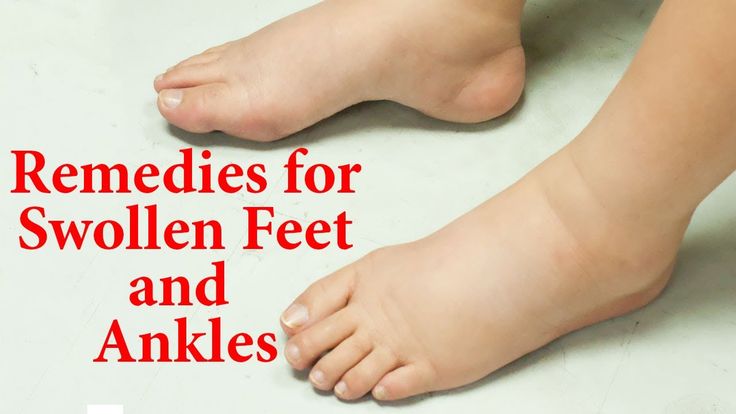 Therefore, even a healthy woman may experience swelling of the legs.
Therefore, even a healthy woman may experience swelling of the legs.
The amount of fluid during pregnancy increases by 6-8 liters. From 4 to 6 of them fall on the placenta, the remaining 2-4 liters are distributed throughout the body.
The mechanism of development of physiological and pathological edema is associated with three factors, including: nine0003
- hormonal changes;
- sodium retention;
- poor outflow of blood from the pelvic organs and legs.
Symptoms
Edema is not always visible visually and is sometimes determined only by weighing. For some women, even 5 liters of excess fluid can be completely invisible, while for others, temporary water retention causes visible swelling in different parts of the body.
nine0002 Typical symptoms of edema:- traces on the skin from socks and seams of clothing that do not “straighten out” for a long time;
- heaviness in the legs, especially in the evening;
- if you press on the shin or foot, a notch remains;
- habitual shoes become tight;
- unable to clench the hand into a fist;
- it is difficult to put on or take off the ring from the finger;
- tingling and slight numbness in the fingers due to compression of the nerves by swollen tissues; nine0034
- puffiness of the face;
- increase in chin, lips, nose in volume.

Book an online consultation if you experience swelling during pregnancy. Our doctors remotely, by phone or video call, will help interpret the symptoms and talk about methods of dealing with edema. Experts on call around the clock, contact for advice at any time.
Which doctor to contact
First you need to go to the gynecologist who leads the pregnancy. He will prescribe an examination and tell you which doctor to book a consultation with. With high pressure and the presence of protein in the urine, preeclampsia can be assumed, which often requires hospitalization. Gynecologists deal with this problem.
If there is a predisposition to varicose veins, heaviness or pain is felt in the legs, then you need to visit a phlebologist.
Alarm symptoms: nine0003
- swelling appears in the morning;
- excess weight gain was recorded in the early stages, already in the 1st trimester;
- constant thirst and decrease in urination when using the usual volume of liquid;
- shortness of breath, a feeling of fullness and heaviness in the chest;
- persistent bags under the eyes;
- swelling rises above the knees.
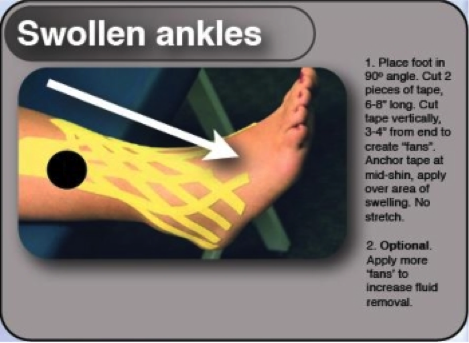
Diagnostics
Sometimes it is not easy to distinguish physiological from pathological edema, so a woman is prescribed an examination. It may include different diagnostic methods:
| Study | What the result shows |
| Analysis of urine nine0003 | In kidney disease, protein is found in the urine |
| Assessment of daily diuresis | Normally, the amount of fluid drunk per day is less than urine excreted by no more than 25%, if this parameter deviates, we can talk about latent edema |
| Biochemistry of blood nine0003 | By the concentration of electrolytes, protein, urea, creatinine, you can evaluate the work of the kidneys and other organs in early and late pregnancy |
| Weighing | Weekly weight gain is normally up to 300 g |
| Blood pressure measurements nine0003 | A large difference in the results of measurements on different hands indicates the development of preeclampsia |
| Fundus examination | According to the condition of the veins of the fundus, one can judge the functioning of the cerebral vessels and the entire vascular system. |
| Blister test | 0.2 ml of saline is injected into the forearm area. Normally, the formed blister resolves in 40-60 minutes. Otherwise, there are hidden edema |
| Ankle diameter measurement | Measurements are taken every week, with increased hydrophilicity of tissues, the circumference of the lower leg increases by more than 1 cm nine0003 |
| Physical examination | The doctor pays attention to the condition and tone of the skin:
|
According to indications, a woman may be prescribed an ultrasound of the pelvic organs, thyroid gland, kidneys, vessels of the lower extremities. In cardiac pathologies, a cardiogram is made, daily Holter monitoring, and phonocardiography are carried out.
In cardiac pathologies, a cardiogram is made, daily Holter monitoring, and phonocardiography are carried out.
How to get rid of edema
You can fight on your own only with physiological edema, and a woman can remove them completely or at least reduce them. But pathological edema requires mandatory medical care, as they are dangerous for the development of complications. nine0003
Diet
The restrictions apply mainly to salt and "harmful" products, in which there is a lot of it - smoked meats, marinades, semi-finished products and canned food. The recommended dose of table salt per day is 1.5 g. If you reduce the amount of sodium entering the body, excess fluid will be more quickly excreted by the kidneys.
It is recommended to lean on products that have a mild diuretic effect. These include most fruits and vegetables - carrots, beets, cucumbers. nine0003
Drinking mode
It is very important to drink at least a liter of water per day, and preferably one and a half, in the absence of contraindications. It will not be possible to avoid edema with a decrease in this volume, because water is needed to replenish the amount of amniotic fluid, remove metabolic products and prepare the body for the upcoming birth.
It will not be possible to avoid edema with a decrease in this volume, because water is needed to replenish the amount of amniotic fluid, remove metabolic products and prepare the body for the upcoming birth.
Case study:
A pregnant woman went to the doctor with complaints of periodic swelling and hot flashes. She has a history of nephrolithiasis, the results of the latest tests are normal. Canephron was prescribed, a low-salt diet, half-bed rest was recommended. When edema appears, lie with your legs elevated, placing a pillow under them, or on your left side. nine0003
Physical activity
Dosed physical activity allows you to remove swelling by at least half. Simple exercise and walking help improve blood circulation, as contracting muscles push blood out of the veins, preventing them from overflowing and thereby making the heart work easier.
To remove swelling from the legs, it is enough to perform exercises every 2 hours for 5-10 minutes.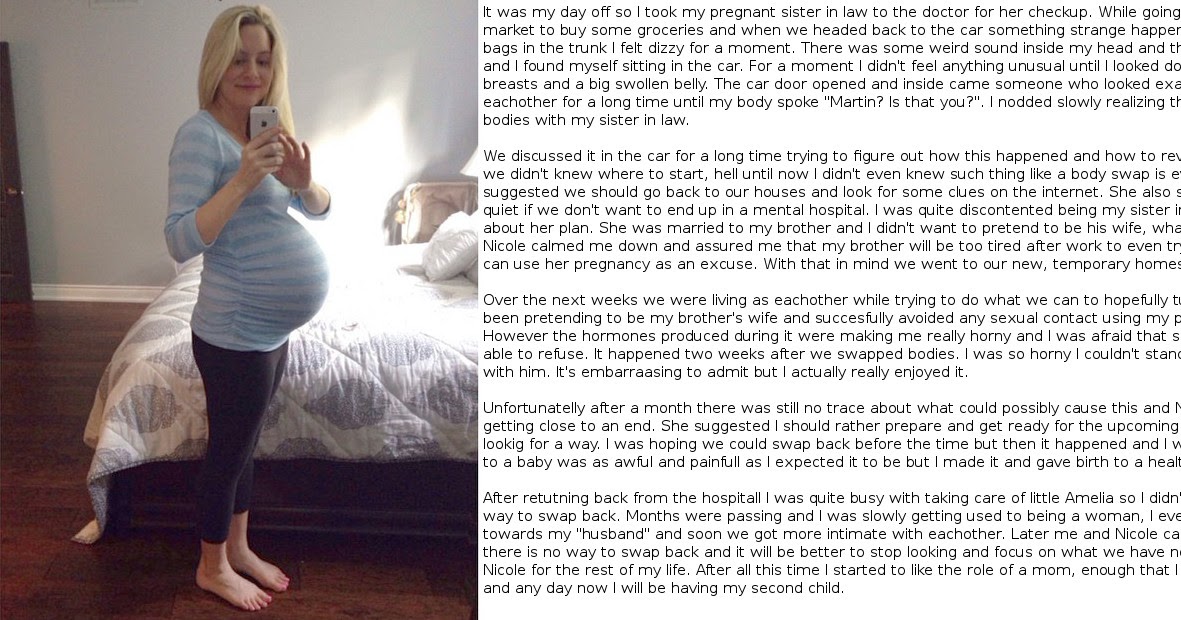 Pregnant women especially benefit from swimming, yoga, and exercise balls. nine0003
Pregnant women especially benefit from swimming, yoga, and exercise balls. nine0003
Sign up for an online consultation to learn more about how to get rid of swelling during pregnancy. Our doctors will remotely tell you about the most effective methods in relation to your case and tell you what to do. Specialists work for you 24 hours a day.
Treatment
To relieve swelling and prevent their occurrence in the future, various drugs are used.
With gestosis, antispasmodics, anticonvulsants, sedatives, as well as drugs to reduce pressure are prescribed. Women with diagnosed kidney pathology are prescribed diuretics, xanthines, potassium preparations, and antithrombotic agents. nine0003
With varicose veins, phlebotonics, anticoagulants, and compression therapy are effective. High blood pressure is reduced with the help of vasodilators, calcium channel blockers, alpha-2 adrenomimetics.
FAQ
What are the dangers of swelling during pregnancy?
+
In the later stages, edema can be a sign of preeclampsia, a very dangerous pathology for both the mother and the child.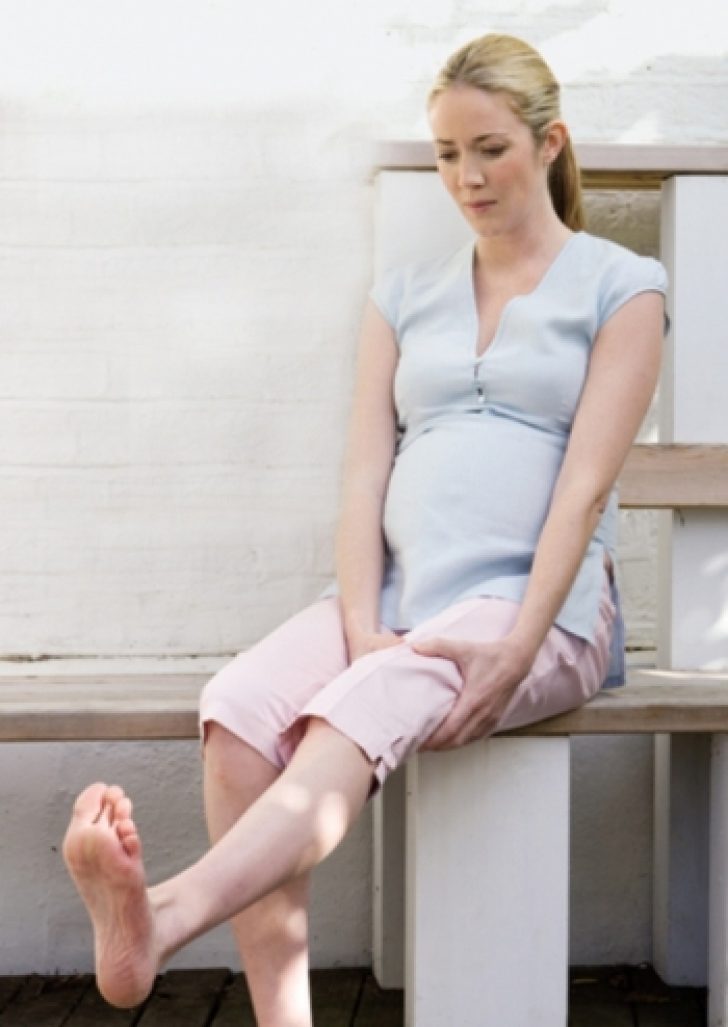 nine0003
nine0003
Can hands swell in the second trimester of pregnancy in the heat? This is fine?
+
Yes, both hands and feet can swell in the second trimester. High temperatures are one of the reasons for the formation of edema.
How does swelling appear in the third trimester?
+
In the later stages, mainly the legs swell, and especially the feet. They swell most noticeably in the afternoon and in the evening. nine0003
Expert opinion
Edema during pregnancy is an almost inevitable companion of a woman "in an interesting position." If there are no pathologies, then there is no reason for concern, you just need to slightly adjust your lifestyle. But this does not cancel planned visits to the gynecologist and regular tests. Remember that you can not drink medicines without a doctor's prescription, so as not to harm yourself and the child.
We publish only verified information nine0003
Article author
Menshikova Maria Viktorovna obstetrician-gynecologist
Experience 38 years
Consultations 1816
Art. 46
46
Specialist with extensive practical experience. He has a certificate of a mammologist, a certificate of professional certification. Participates in foreign business trips and individual training programs (Los Angeles).
- 1982 - 1986 NPO MONIIAG - obstetrician-gynecologist
- 1987 - 1989 VNITs OZMIR - obstetrician-gynecologist
- 1989 - 1992 departmental polyclinic st. Moscow - Kurskaya - obstetrician-gynecologist
- 1992 - 2001 NPO MONIIAG - obstetrician-gynecologist
- 2007 - 2008 NP KMIKM - doctor administrator
- 2009 - 2013 Pereslavl Central District Hospital, women's consultation - obstetrician-gynecologist
- 2020 to present Teledoctor24 LLC - doctor - consultant (gynecologist)
How to remove swelling during pregnancy and why they are dangerous
Edema during pregnancy appears in most women "in position". Most often, they notice swelling in the third trimester, after 30 weeks, however, with late toxicosis, symptoms of fluid retention appear as early as the 18th week. nine0003
nine0003
General information
During the period of bearing a child in a woman's body, the volume of fluid increases significantly, at least twice. As a result, the internal organs experience increased stress, which leads to swelling.
Most often in pregnant women, the legs swell in the area of \u200b\u200bthe feet and ankles, because under the influence of gravity, the water descends. But over time, swelling can spread to the hands, face, and sometimes the whole body. nine0003
Species
Given the prevalence, swelling during pregnancy is of 2 types:
1. Localized (local)
When only one part of the body swells - legs, arms or face.
2. Generalized (generalized)
In which edema spreads to the whole body.
Generalized edema is called dropsy of pregnancy and is a consequence of the release of plasma into the intercellular space. Puffiness is generally characteristic of late toxicosis, or gestosis, but it manifests itself with varying degrees of severity. nine0003
nine0003
In some cases, gestosis is quite difficult and is accompanied by such conditions as:
- nephropathy
It develops against the background of dropsy in about a quarter of women. With nephropathy, blood pressure rises, dizziness, lower back pain, and digestive problems;
- pre-eclampsia
The next stage after nephropathy with the preservation of edema and the appearance of severe headache, weakness, nausea, turning into vomiting. Typical signs of preeclampsia are drowsiness, blurred vision, lethargy and trembling in the hands; nine0003
- eclampsia
Replaces preeclampsia and lasts no more than 3-4 days. The clinical picture includes severe edema and other symptoms of preeclampsia, against which a convulsive attack appears, turning into a coma. The coma can either get worse or end with the restoration of consciousness.
General edema in pregnant women causes a change in the composition of the blood, which, in turn, leads to fetal hypoxia.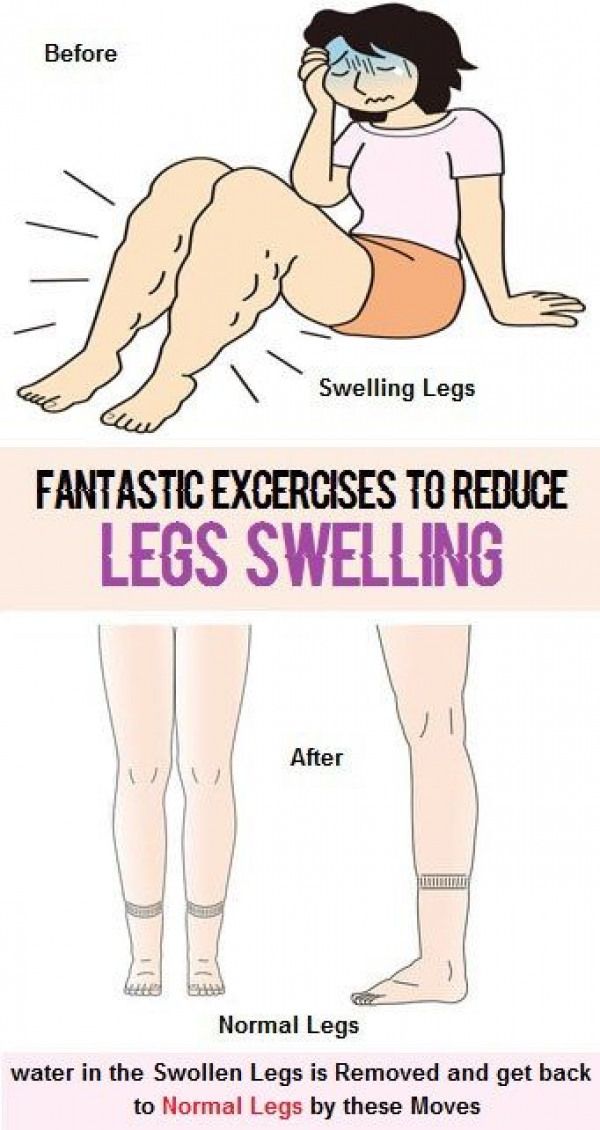 Edema can be both obvious and hidden: the first is visible to the naked eye, and the second is determined by too sharp weight gain. nine0003
Edema can be both obvious and hidden: the first is visible to the naked eye, and the second is determined by too sharp weight gain. nine0003
Attention! If during pregnancy weight gain was more than 18 kg, then doctors ascertain internal edema. The volume of fluid consumed significantly exceeds the amount of urine excreted.
Causes of edema in pregnancy
Edema during gestation can be physiological and pathological. Fluid retention in both cases is due to hormonal fluctuations. Already from the first weeks of pregnancy, the level of progesterone begins to rise, which is necessary to reduce the contractile activity of the uterus and prevent miscarriage. nine0003
In the first trimester, the concentration of progesterone already increases 10 times! And the same hormone prevents the excretion of sodium and water from the body, as the need for fluid also increases.
Why pregnant women need more fluids:
- The volume of circulating blood should be sufficient for the blood supply to the fetus.

- The formation of the placenta and amniotic fluid is impossible with the same amount of fluid. nine0034
The growing uterus puts pressure on the vessels, thereby provoking stagnation of blood in the pelvic organs and lower extremities. Therefore, even a healthy woman may experience swelling of the legs.
The amount of fluid during pregnancy increases by 6-8 liters. From 4 to 6 of them fall on the placenta, the remaining 2-4 liters are distributed throughout the body.
The mechanism of development of physiological and pathological edema is associated with three factors, including: nine0003
- hormonal changes;
- sodium retention;
- poor outflow of blood from the pelvic organs and legs.
Symptoms
Edema is not always visible visually and is sometimes determined only by weighing. For some women, even 5 liters of excess fluid can be completely invisible, while for others, temporary water retention causes visible swelling in different parts of the body.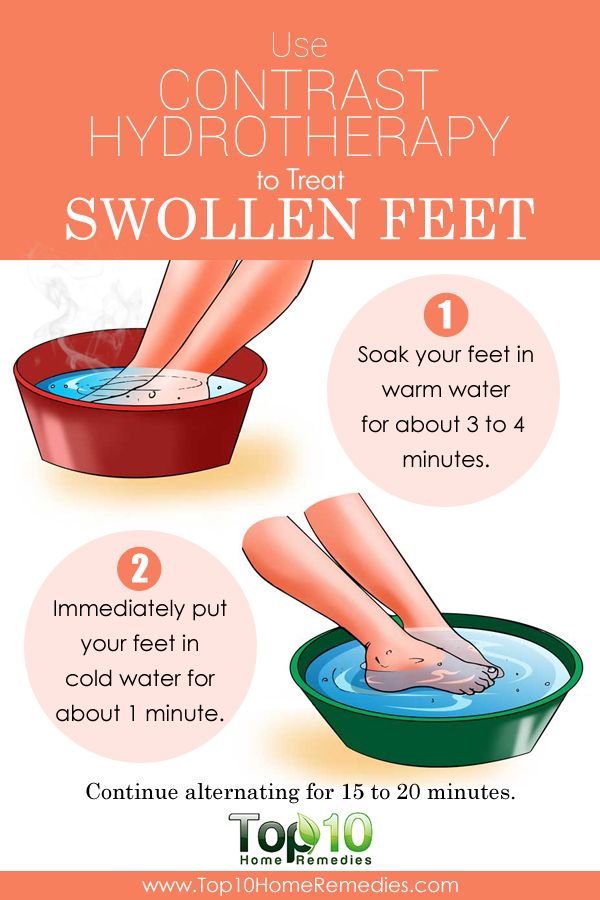
- traces on the skin from socks and seams of clothing that do not “straighten out” for a long time;
- heaviness in the legs, especially in the evening;
- if you press on the shin or foot, a notch remains;
- habitual shoes become tight;
- unable to clench the hand into a fist;
- it is difficult to put on or take off the ring from the finger;
- tingling and slight numbness in the fingers due to compression of the nerves by swollen tissues; nine0034
- puffiness of the face;
- increase in chin, lips, nose in volume.
Book an online consultation if you experience swelling during pregnancy. Our doctors remotely, by phone or video call, will help interpret the symptoms and talk about methods of dealing with edema. Experts on call around the clock, contact for advice at any time.
Which doctor to contact
First you need to go to the gynecologist who leads the pregnancy. He will prescribe an examination and tell you which doctor to book a consultation with. With high pressure and the presence of protein in the urine, preeclampsia can be assumed, which often requires hospitalization. Gynecologists deal with this problem.
He will prescribe an examination and tell you which doctor to book a consultation with. With high pressure and the presence of protein in the urine, preeclampsia can be assumed, which often requires hospitalization. Gynecologists deal with this problem.
If there is a predisposition to varicose veins, heaviness or pain is felt in the legs, then you need to visit a phlebologist.
Alarm symptoms: nine0003
- swelling appears in the morning;
- excess weight gain was recorded in the early stages, already in the 1st trimester;
- constant thirst and decrease in urination when using the usual volume of liquid;
- shortness of breath, a feeling of fullness and heaviness in the chest;
- persistent bags under the eyes;
- swelling rises above the knees.
Diagnostics
Sometimes it is not easy to distinguish physiological from pathological edema, so a woman is prescribed an examination. It may include different diagnostic methods:
It may include different diagnostic methods:
| Study | What the result shows |
| Analysis of urine nine0003 | In kidney disease, protein is found in the urine |
| Assessment of daily diuresis | Normally, the amount of fluid drunk per day is less than urine excreted by no more than 25%, if this parameter deviates, we can talk about latent edema |
| Biochemistry of blood nine0003 | By the concentration of electrolytes, protein, urea, creatinine, you can evaluate the work of the kidneys and other organs in early and late pregnancy |
| Weighing | Weekly weight gain is normally up to 300 g |
| Blood pressure measurements nine0003 | A large difference in the results of measurements on different hands indicates the development of preeclampsia |
| Fundus examination | According to the condition of the veins of the fundus, one can judge the functioning of the cerebral vessels and the entire vascular system. |
| Blister test | 0.2 ml of saline is injected into the forearm area. Normally, the formed blister resolves in 40-60 minutes. Otherwise, there are hidden edema |
| Ankle diameter measurement | Measurements are taken every week, with increased hydrophilicity of tissues, the circumference of the lower leg increases by more than 1 cm nine0003 |
| Physical examination | The doctor pays attention to the condition and tone of the skin:
|
According to indications, a woman may be prescribed an ultrasound of the pelvic organs, thyroid gland, kidneys, vessels of the lower extremities. In cardiac pathologies, a cardiogram is made, daily Holter monitoring, and phonocardiography are carried out.
In cardiac pathologies, a cardiogram is made, daily Holter monitoring, and phonocardiography are carried out.
How to get rid of edema
You can fight on your own only with physiological edema, and a woman can remove them completely or at least reduce them. But pathological edema requires mandatory medical care, as they are dangerous for the development of complications. nine0003
Diet
The restrictions apply mainly to salt and "harmful" products, in which there is a lot of it - smoked meats, marinades, semi-finished products and canned food. The recommended dose of table salt per day is 1.5 g. If you reduce the amount of sodium entering the body, excess fluid will be more quickly excreted by the kidneys.
It is recommended to lean on products that have a mild diuretic effect. These include most fruits and vegetables - carrots, beets, cucumbers. nine0003
Drinking mode
It is very important to drink at least a liter of water per day, and preferably one and a half, in the absence of contraindications.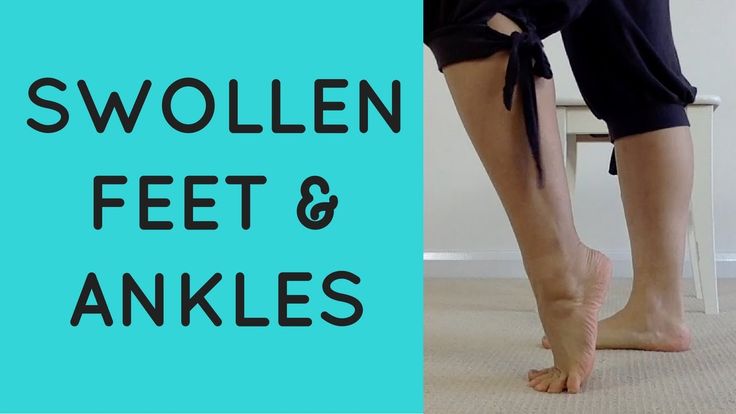 It will not be possible to avoid edema with a decrease in this volume, because water is needed to replenish the amount of amniotic fluid, remove metabolic products and prepare the body for the upcoming birth.
It will not be possible to avoid edema with a decrease in this volume, because water is needed to replenish the amount of amniotic fluid, remove metabolic products and prepare the body for the upcoming birth.
Case study:
A pregnant woman went to the doctor with complaints of periodic swelling and hot flashes. She has a history of nephrolithiasis, the results of the latest tests are normal. Canephron was prescribed, a low-salt diet, half-bed rest was recommended. When edema appears, lie with your legs elevated, placing a pillow under them, or on your left side. nine0003
Physical activity
Dosed physical activity allows you to remove swelling by at least half. Simple exercise and walking help improve blood circulation, as contracting muscles push blood out of the veins, preventing them from overflowing and thereby making the heart work easier.
To remove swelling from the legs, it is enough to perform exercises every 2 hours for 5-10 minutes. Pregnant women especially benefit from swimming, yoga, and exercise balls. nine0003
Pregnant women especially benefit from swimming, yoga, and exercise balls. nine0003
Sign up for an online consultation to learn more about how to get rid of swelling during pregnancy. Our doctors will remotely tell you about the most effective methods in relation to your case and tell you what to do. Specialists work for you 24 hours a day.
Treatment
To relieve swelling and prevent their occurrence in the future, various drugs are used.
With gestosis, antispasmodics, anticonvulsants, sedatives, as well as drugs to reduce pressure are prescribed. Women with diagnosed kidney pathology are prescribed diuretics, xanthines, potassium preparations, and antithrombotic agents. nine0003
With varicose veins, phlebotonics, anticoagulants, and compression therapy are effective. High blood pressure is reduced with the help of vasodilators, calcium channel blockers, alpha-2 adrenomimetics.
FAQ
What are the dangers of swelling during pregnancy?
+
In the later stages, edema can be a sign of preeclampsia, a very dangerous pathology for both the mother and the child. nine0003
nine0003
Can hands swell in the second trimester of pregnancy in the heat? This is fine?
+
Yes, both hands and feet can swell in the second trimester. High temperatures are one of the reasons for the formation of edema.
How does swelling appear in the third trimester?
+
In the later stages, mainly the legs swell, and especially the feet. They swell most noticeably in the afternoon and in the evening. nine0003
Expert opinion
Edema during pregnancy is an almost inevitable companion of a woman "in an interesting position." If there are no pathologies, then there is no reason for concern, you just need to slightly adjust your lifestyle. But this does not cancel planned visits to the gynecologist and regular tests. Remember that you can not drink medicines without a doctor's prescription, so as not to harm yourself and the child.
We publish only verified information nine0003
Article author
Menshikova Maria Viktorovna obstetrician-gynecologist
Experience 38 years
Consultations 1816
Art.
 If the veins are dilated, then the blood stagnates, which leads to circulatory disorders nine0003
If the veins are dilated, then the blood stagnates, which leads to circulatory disorders nine0003  If the veins are dilated, then the blood stagnates, which leads to circulatory disorders nine0003
If the veins are dilated, then the blood stagnates, which leads to circulatory disorders nine0003 
